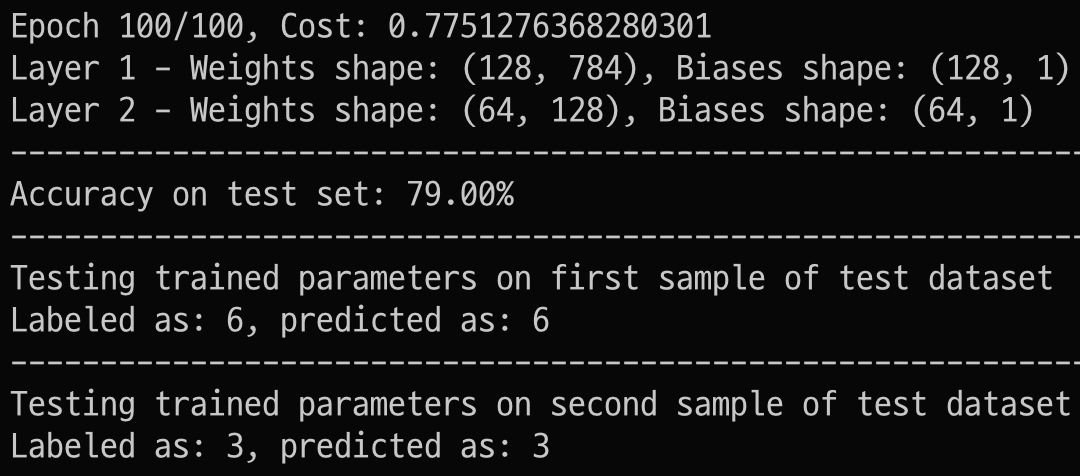forward propagation (computing the output of a neural network):
- Single Neurons & activation functions
- Neural Networks (multi-layer perceptron) & walkthrough handwirting interpretation
back propagation (updating the network's weights by correcting its mistakes):
This project implements a simple neural network to classify handwritten numbers from the mnist dataset. You can define the number of layers, neurons per layer, activation functions, and other training parameters via command-line arguments.
The following libraries are used:
- zipfile: For extracting dataset files.
- numpy: For numerical computations.
- pandas: For data manipulation.
- matplotlib.pyplot: For plotting images.
- sklearn.metrics: For evaluating the model's performance.
Dataset Loading
- Extract the dataset from a ZIP file and load it into a Pandas DataFrame.
- Convert the DataFrame to a NumPy array and prepare the training and test datasets.
Dataset Preparation
- Shuffle the dataset and split it into training and test sets.
- Normalize the features to ensure pixel values are between 0 and 1.
Initialize Parameters
- Define a function to initialize random weights and biases for each layer in the network.
Activation Functions
- Implement the ReLU and Softmax activation functions.
Forward Propagation
- Define a function to perform forward propagation through the network using the activation functions.
Cost Function Calculation
- Implement a cost function to calculate the cross-entropy loss between predictions and true labels.
Backward Propagation
- Define a function to perform backward propagation to compute gradients of the cost function with respect to the parameters.
Parameter Update
- Implement gradient descent to update the parameters using the computed gradients.
Train Network
- Define a function to train the neural network using the training data, specified architecture, learning rate, and tolerance for convergence.
Predict
- Implement a function to predict labels for given input features using the trained network.
Predict Single Example
- Define a function to predict the label for a single input sample.
- Implement a function to visualize an input image and compare the true label with the predicted label.
# install dependencies
pip install -r requirements.txt
# get to know the dataset
python visualize_mnist.py
# train network with default parameters
python neural_network.py
# train neural_network with specific parameters (don't specify to use the default option)
python neural_network.py --layers <layer_sizes> --activations <activation_functions> --learning_rate <learning_rate> --max_iterations <iterations> --tolerance <tolerance> --train_file <train_file> --test_file <test_file>--layers: Neurons per layer (default:128 64 10).--activations: Activation functions per layer (default:relu relu softmax).--learning_rate: Learning rate for training (default:0.01).--max_iterations: Max training iterations (default:200).--tolerance: Cost change tolerance for stopping (default:0.001).--train_file: Path to the ZIP file with the training CSV (default:./input/train.csv.zip).--test_file: Path to the ZIP file with the test CSV (default./input/test.csv.zip).
python neural_network.py --layers 128 64 10 --activations relu relu softmax --learning_rate 0.01 --max_iterations 200 --tolerance 0.001 --train_file ./data/train.csv.zip --test_file ./data/test.csv.ziphave fun tinkering :)
